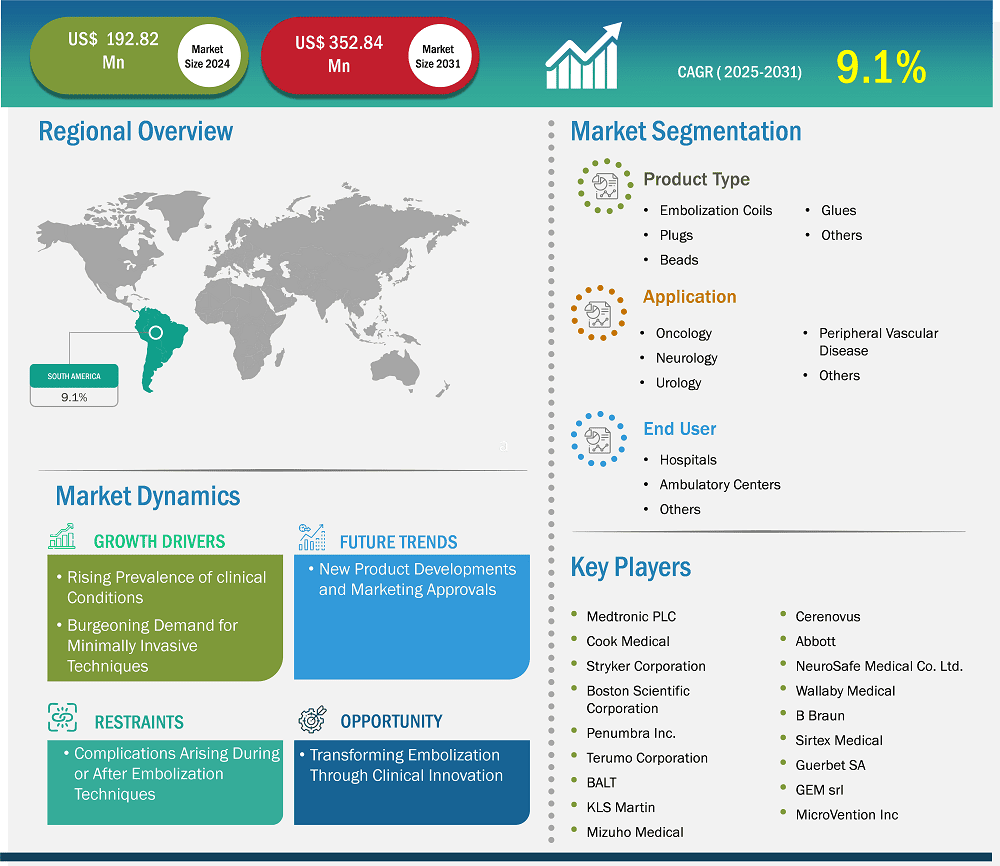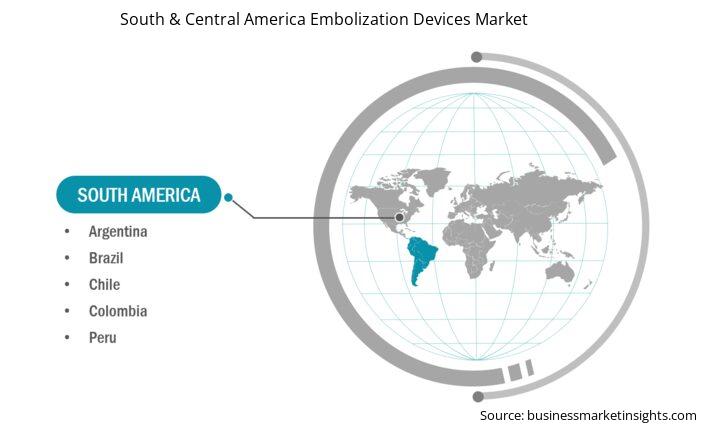South & Central America Embolization Devices Market Report (2021-2031) by Scope, Segmentation, Dynamics, and Competitive Analysis
No. of Pages: 174 | Report Code: BMIRE00032150 | Category: Life Sciences
No. of Pages: 174 | Report Code: BMIRE00032150 | Category: Life Sciences
The South & Central America embolization devices market size is expected to reach US$ 352.84 million by 2031 from US$ 192.82 million in 2024. The market is estimated to record a CAGR of 9.1% from 2025 to 2031.
The South & Central America embolization devices market is segmented into Brazil, Argentina, and the Rest of South & Central America. The regional market is expected to experience lucrative opportunities due to rising prevalence of various clinical conditions, such as trauma, growing developments in healthcare systems, and rising awareness about the chronic conditions in the region. In addition, the growing population adopting unhealthy lifestyles leads to higher susceptibility of diseases in turn boosting the demand for these devices in South & Central America. Also, increasing government initiatives are anticipated to drive the embolization devices market in the region. The region's rapidly growing aging population and increasing healthcare expenditure are also fueling demand for advanced medical treatments. Countries like Brazil and Mexico are investing in healthcare infrastructure and attracting foreign direct investment, which supports the adoption of advanced medical technologies.

Key segments that contributed to the derivation of the South & Central America embolization devices market analysis are type, application, and end user.
Innovations such as improved catheter designs, new embolic agents, and detachable coils have enhanced the efficacy and safety of embolization procedures. For example, the development of flow-diverting devices has revolutionized the treatment of complex intracranial aneurysms by redirecting blood flow away from the aneurysm sac, promoting thrombosis within the aneurysm.
Clinical studies are pivotal in advancing embolization techniques, leading to broader indications and improved patient outcomes. For instance, the IMPASS embolic coil device developed by Fluidx Medical Technology has shown promise in treating chronic subdural hematomas by embolizing the middle meningeal artery (MMA) in January 2023, as demonstrated in in-vivo studies. The Fluidx embolic platform is expected to bring simple preparation and controllable material delivery to various applications.
With the numerous applications for peripheral vascular embolization and the wide range of vessel sizes to be treated, no single agent or device fits all indications. The article titled "Results from the First-in-Human Study of the Caterpillar Arterial Embolization System," published in November 2022, assessed occlusion success and events associated with the use of a self-expanding device for peripheral artery embolization. The study was based on clinical outcomes of the Caterpillar Arterial Embolization Device, which features opposing nitinol fibers and a flow-occluding membrane. The device is designed for use in a broad range of arteries, aiming to reduce the number of devices required to achieve effective occlusion. In this first-in-human trial, the Caterpillar device was successfully deployed to embolize peripheral arteries. The procedure resulted in periprocedural occlusion in all participants and demonstrated a 94.7% rate of freedom from device-related serious adverse events (SAEs) at 30 days. The findings also suggest that the Caterpillar device can be used with minimal risk of SAEs related to the device or procedure.
As the market continues to evolve, the synergy between clinical research and device innovation will be crucial in addressing the growing demand for effective embolization therapies. Therefore, the integration of clinical studies into the development of embolization devices, fostering significant advancements in the field and leading to expanded treatment options and improved patient outcomes, is emerging as a significant trend in the embolization devices market.
Based on country, the South & Central America embolization devices market comprises Brazil, Argentina, and the Rest of South & Central America. Brazil held the largest share in 2024.
According to the article “Latin America Trauma Systems,” published by the Orthopedic Trauma Association in Brazil, trauma is the third most significant cause of death in Brazil, accounting for 12.5% of all deaths. It is the leading cause of death among individuals from the age group of 1–39, with a mortality rate of 70.5 cases per 100,000 population, and men account for 83.1% of the total count of death cases. An embolization procedure is performed to control bleeding from injured organs (liver, spleen, pelvis, etc.) following accidents. In Brazil, abdominal aortic aneurysms are the most common type of aortic aneurysms. The condition is more common in people over the age of 60. According to the Pan American Health Organization, Brazil had more than 30 million people who were aged 60 years and above, representing 13% of the country's population. By 2031, the population of this age group will reach nearly 50 million, accounting for 24% of the total Brazilian population that year. As per the Brazil Statistical Institute, nearly 36% of its total population will be aged 65 or more by 2050. Embolization procedures have become increasingly important in the treatment of various medical conditions in the aged population, largely due to their minimally invasive nature and adaptability to complex health profiles that are common in older adults. Moreover, embolization is often preferred over open surgeries because it carries lower risk and requires shorter recovery times.
| Report Attribute | Details |
|---|---|
| Market size in 2024 | US$ 192.82 Million |
| Market Size by 2031 | US$ 352.84 Million |
| CAGR (2025 - 2031) | 9.1% |
| Historical Data | 2021-2023 |
| Forecast period | 2025-2031 |
| Segments Covered |
By Type
|
| Regions and Countries Covered | South and Central America
|
| Market leaders and key company profiles |
|
Some of the key players operating in the market include Medtronic Plc; Cook Medical Holdings LLC; Stryker Corp; Boston Scientific Corp; Terumo Corp; Johnson & Johnson; Abbott Laboratories; NeuroSafe Medical Co. Ltd; Wallaby Medical; Sirtex Medical Ltd; GEM srl; Penumbra Inc.; Balt; Lepu Medical Technology Beijing Co Ltd; INVAMED; Meril Life Sciences Pvt Ltd; Merit Medical Systems Inc; and Lifetech Scientific Corp among others. These players are adopting various strategies such as expansion, product innovation, and mergers and acquisitions to provide innovative products to their consumers and increase their market share.
The following methodology has been followed for the collection and analysis of data presented in this report:
The research process begins with comprehensive secondary research, utilizing both internal and external sources to gather qualitative and quantitative data for each market. Commonly referenced secondary research sources include, but are not limited to:
Note: All financial data included in the Company Profiles section has been standardized to USD. For companies reporting in other currencies, figures have been converted to USD using the relevant exchange rates for the corresponding year.
The Insights Partners conducts a significant number of primary interviews each year with industry stakeholders and experts to validate its data analysis and gain valuable insights. These research interviews are designed to:
Primary research is conducted via email interactions and telephone interviews, encompassing various markets, categories, segments, and sub-segments across different regions. Participants typically include:

The South & Central America Embolization Devices Market is valued at US$ 192.82 Million in 2024, it is projected to reach US$ 352.84 Million by 2031.
As per our report South & Central America Embolization Devices Market, the market size is valued at US$ 192.82 Million in 2024, projecting it to reach US$ 352.84 Million by 2031. This translates to a CAGR of approximately 9.1% during the forecast period.
The South & Central America Embolization Devices Market report typically cover these key segments-
The historic period, base year, and forecast period can vary slightly depending on the specific market research report. However, for the South & Central America Embolization Devices Market report:
The South & Central America Embolization Devices Market is populated by several key players, each contributing to its growth and innovation. Some of the major players include:
The South & Central America Embolization Devices Market report is valuable for diverse stakeholders, including:
Essentially, anyone involved in or considering involvement in the South & Central America Embolization Devices Market value chain can benefit from the information contained in a comprehensive market report.